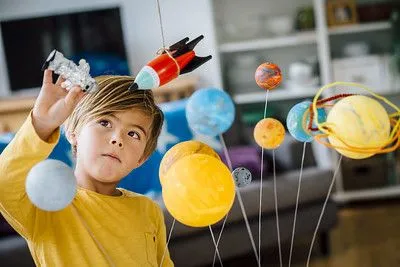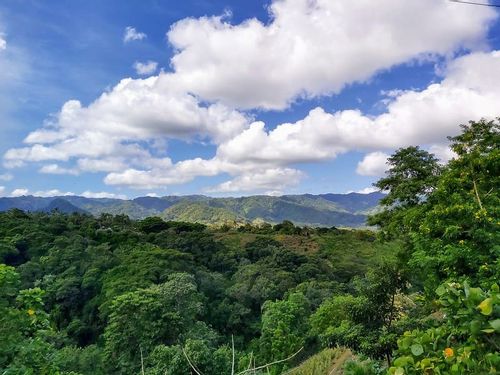FOR ALL AGES
All kids love the mystery and adventure of space exploration. And it’s a great time to take an interest. This decade should see humans return to the Moon, with a mission to Mars also on the cards. Meanwhile, we’re learning ever more about planets around other stars, and finding tentative hints about the possibility of life elsewhere in the cosmos.
But how much do you and your children know about space exploration? Try our fiendish quiz, compiled by veteran science quizmaster Matt Brown. The questions are aimed at older children, teens and their parents.
See also: 10 space activities for kids.
1. What is astronaut Buzz Aldrin’s real first name?
2. Which alcoholic beverage was the first to be consumed on the moon?
3. Which TV show has main characters named after the first five US astronauts.
4. An estimated 530 million people tuned in to watch the first moon-landing in July 1969. What percentage of the world’s population did this represent?
5. There’s only one piece of art on the Martian surface. Who created it?
6. With which song did astronaut Chris Hadfield become a YouTube sensation in 2013?
7. In what year was the first photograph of the Earth from space taken? (a) 1947, (b) 1957, (c) 1967.
8. Which scientist/inventor gave his name to the first production car to enter space?
9. In 2017, four NASA employees -- Nancy Grace Roman, Margaret Hamilton, Sally Ride and Mae Jemison -- were commemorated in what unusual way?
10. A grim but intriguing one to finish. How many people have died in space (as of May 2018)?
1. What name, describing the beginning of the Universe, was coined by an astronomer who never believed in it?
2. What is the common name of the constellation Ursa Major, and what are the alternative North American and UK names for the part of the constellation made from its seven brightest stars?
3. If the Sun suddenly disappeared, how many minutes would it take before the Earth was plunged into darkness?
4. The VLT in northern Chile is one of the world’s leading telescope facilities. What does VLT stand for?
5. Name the only planet or moon in the solar system to have no consonants in its name.
6. How many planets feature in Gustav Holst’s The Planets (1914-16)?
7. In 2011, which planet had completed one whole year (from its perspective) since its discovery?
8. Which is the only planet in our solar system whose English name is not that of a Greek or Roman deity?
9. Which planet in our solar system has moons named after water gods and nymphs?
10. The craters on Mercury tend to be named after creative people. Which of the following is NOT a crater on Mercury? (a) Warhol, (b) Tolkien, (c) Disney, (d) Plath, (e) Kahlo

1. It is actually Buzz. He had it changed officially in 1988. His birth name, and the one he took to the Moon, was Edwin. Have a point for either!
2. Red wine (as part of a communion conducted by Buzz Aldrin).
3. Thunderbirds. This popular 1960s puppet show, revived in 2015 as Thunderbirds Are Go!, is fronted by the Tracy brothers, who are named after Scott Carpenter, John Glenn, Alan Shepard, Gordon Cooper and Virgil Grissom.
4. 14 percent. A remarkable figure given that TVs were not yet ubiquitous.
5. Damien Hirst. The artist provided one of his trademark spot patterns as a camera calibration target on the ill-fated Beagle 2 lander. The probe went missing during landing in 2003, but is thought to be intact.
6. Space Oddity. He sang it aboard the International Space Station.
7. (a) 1947. German V2 rockets had made brief forays into space more than a decade before Sputnik became the first to achieve orbit. A US flight on a captured V2 took the first pictures of Earth from over 100 miles altitude on 7 March 1947.
8. (Nikola) Tesla. A Tesla car was launched as a dummy payload aboard the first SpaceX Falcon Heavy launch in 2018.
9. As a Lego set (‘Women of NASA’) celebrating their work.
10. Three. The crew of Soyuz 11 in 1971 died when their capsule depressurised. Other tragedies such as the two shuttle disasters occurred within the atmosphere.
1. The Big Bang, coined by Fred Hoyle.
2. The Great Bear, which includes the Plough (UK), or the Big Dipper (USA).
3. A little over 8 minutes, this being the time it takes light to travel from the surface of the Sun to the Earth. Because the Earth’s orbit is elliptical, the exact figure changes, but it averages at 8 minutes, 20 seconds.
4. The Very Large Telescope. An ELT (Extremely Large Telescope) is currently under construction.
5. Io, the volcanic moon of Jupiter.
6. Seven. The planets are linked to astrology and so Earth does not feature. Pluto, which would temporarily become the ninth planet, had not yet been discovered.
7. Neptune. The planet was discovered in 1846 and takes 164.8 Earth years to complete an orbit.
8. Earth.
9. Neptune (again), who was himself the Roman god of the seas.
10. (e) Kahlo. Mexican painter Frida Kahlo did, however, inspire the name of a crater on Venus and a minor planet.
18-20, Space Ace!; 15-17. You’ve earned your astronaut’s wings; 10-14, Nominal trajectory; 5-9, Space oddity; 0-4, Stuck on the launchpad.
Questions adapted from the author’s book The Astounding Science Puzzle Book, from Batsford.
Are these space museums in your orbit?
Read The Disclaimer
At Kidadl we pride ourselves on offering families original ideas to make the most of time spent together at home or out and about, wherever you are in the world. We strive to recommend the very best things that are suggested by our community and are things we would do ourselves - our aim is to be the trusted friend to parents.
We try our very best, but cannot guarantee perfection. We will always aim to give you accurate information at the date of publication - however, information does change, so it’s important you do your own research, double-check and make the decision that is right for your family.
Kidadl provides inspiration to entertain and educate your children. We recognise that not all activities and ideas are appropriate and suitable for all children and families or in all circumstances. Our recommended activities are based on age but these are a guide. We recommend that these ideas are used as inspiration, that ideas are undertaken with appropriate adult supervision, and that each adult uses their own discretion and knowledge of their children to consider the safety and suitability.
Kidadl cannot accept liability for the execution of these ideas, and parental supervision is advised at all times, as safety is paramount. Anyone using the information provided by Kidadl does so at their own risk and we can not accept liability if things go wrong.
Kidadl is independent and to make our service free to you the reader we are supported by advertising.
We hope you love our recommendations for products and services! What we suggest is selected independently by the Kidadl team. If you purchase using the buy now button we may earn a small commission. This does not influence our choices. Please note: prices are correct and items are available at the time the article was published.
Kidadl has a number of affiliate partners that we work with including Amazon. Please note that Kidadl is a participant in the Amazon Services LLC Associates Program, an affiliate advertising program designed to provide a means for sites to earn advertising fees by advertising and linking to amazon.
We also link to other websites, but are not responsible for their content.
Was this article helpful?



Browse Category



We’ll send you tons of inspiration to help you find a hidden gem in your local area or plan a big day out.



Check your inbox for your latest news from us. You have subscribed to:
Remember that you can always manage your preferences or unsubscribe through the link at the foot of each newsletter.